GREEN THUMB
With support from CSU Spur, a new face of farming blooms at Bruce Randolph School.
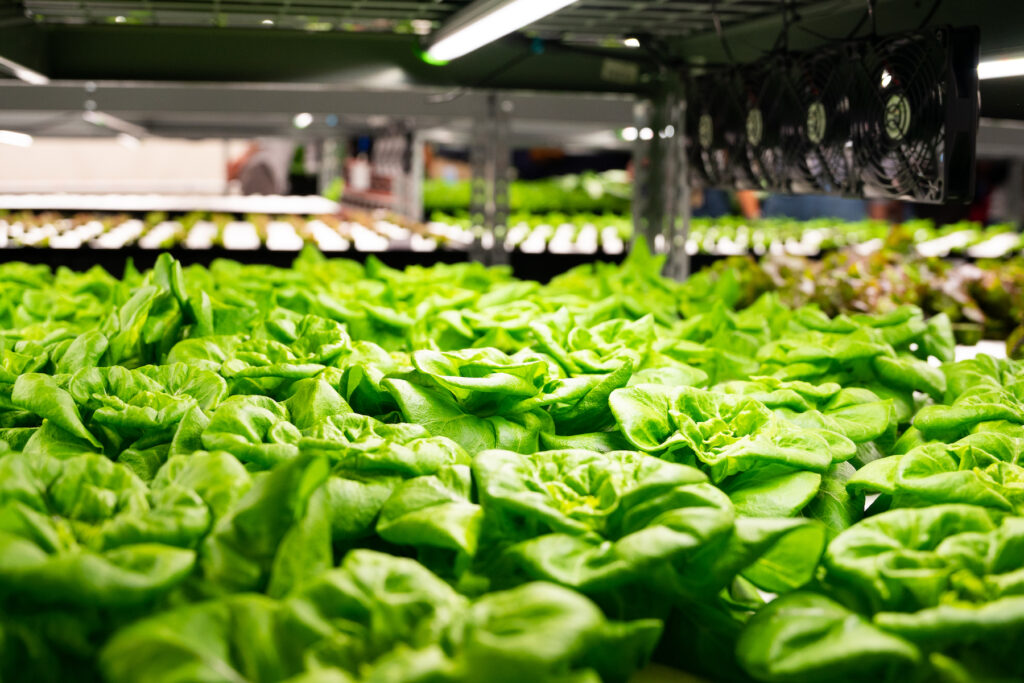
GREEN THUMB
With support from CSU Spur, a new face of farming blooms at Bruce Randolph School.
By Nancy Lofholm | Photography by Vance Jacobs | July 1, 2022
ON A SPRING MORNING AT BRUCE RANDOLPH SCHOOL IN NORTH DENVER, 23 students were at their tables in a backpack-rustling state of first-period readiness. Jennifer Bousselot, an assistant professor of horticulture at Colorado State University, described a science experiment they would conduct to observe photosynthesis. It would be a moment of wonderment about the workings of plants – and, even more important, a potential stepping stone toward college and careers for a group of motivated teenagers.
Following Bousselot’s instructions, the juniors and seniors divided into teams and started work on small piles of spinach. They used hole punchers to slice tiny disks from the leaves. Each team prepared two clear plastic cups, filling one with water and a pinch of baking soda – a source of carbon – and the other with plain water. Each group then dropped 10 disks of plant tissue into one cup and 10 into the other; they shone cellphone lights over the cups as the disks slowly sank to the bottom.
Bousselot reminded students that they could expect this movement to reverse in one cup – reflecting a process necessary to all life on Earth. Through photosynthesis, plants convert light, water, and carbon dioxide into oxygen and energy. The oxygen byproduct released during photosynthesis is essential to life. “It is the most important series of chemical reactions on the planet,” Bousselot told students.
They soon saw the process in action. After a few minutes, disks in cups with baking soda became buoyant as plant tissue transformed carbon and light into oxygen and glucose. The green circles began to float upward. “Oh, look! You have one starting. That’s creating oxygen right there,” Bousselot exclaimed, as she checked on one group’s bobbing spinach rounds.

Jackeline Carrillo is a college-bound junior taking Horticulture 100 at Bruce Randolph School.
The students caught her enthusiasm. “Oh, my gosh! Look, this cup has another one,” Alejandra Avila told her friends, while watching a disk begin to rise, as if tickled into upward motion.
“On this side, there are none,” Jackeline Carrillo reported back, as she watched spinach rounds stuck to the bottom of the team’s cup of plain water, the experimental control.
As the experiment reached the 8-minute mark, spinach disks across the room had done their job by demonstrating photosynthesis in carbon-infused water while remaining rock bottom without the magic ingredient.
“All of them went up,” Avila said of her team’s spinach rounds. “That’s so cool.”
Students in this beginning horticulture course, called HORT 100, had just learned a college-level lesson in a class that represents a unique partnership between CSU Spur and Bruce Randolph School. For several years, the Colorado State University System has worked closely with Bruce Randolph, a public school with about 700 students in grades 6-12, most from the low-income neighborhoods near the CSU Spur campus at the National Western Center.
The partnership is designed to share educational resources with a school that has been hailed nationwide for its academic about-face: In the past 15 years, Bruce Randolph has transformed from its status as one of Denver’s lowest-performing schools into a success story with five-year graduation rates of 97 percent and admirable college readiness among students. The school’s turnaround has been so remarkable that former President Barack Obama praised Bruce Randolph in a State of the Union address.

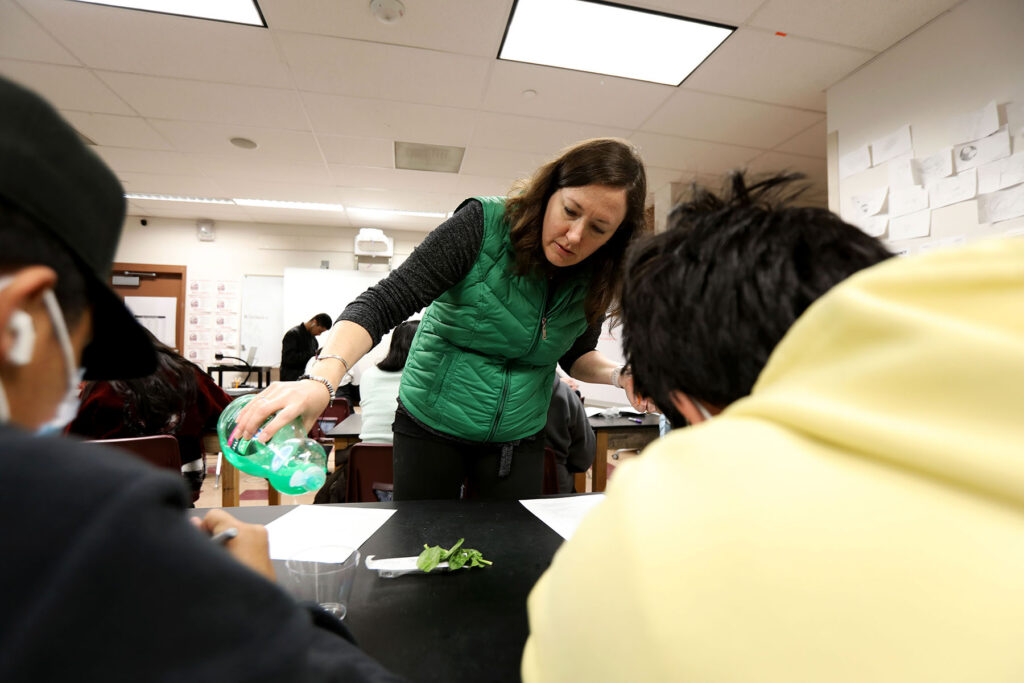
Left: Alejandra Avila, Jackeline Carrillo, and Brisa Reyes conduct a photosynthesis experiment in a science classroom at Bruce Randolph School. Right: Jennifer Bousselot, an assistant professor of horticulture at CSU, co-taught the HORT 100 class with Bruce Randolph teacher Rhiannon Torino. Bousselot was a first-generation college student and earned her Ph.D. at CSU.
Top: Alejandra Avila, Jackeline Carrillo, and Brisa Reyes conduct a photosynthesis experiment in a science classroom at Bruce Randolph School. Bottom: Jennifer Bousselot, an assistant professor of horticulture at CSU, co-taught the HORT 100 class with Bruce Randolph teacher Rhiannon Torino. Bousselot was a first-generation college student and earned her Ph.D. at CSU.
The CSU System partnered with Bruce Randolph to deliver on its commitment to neighborhoods around the CSU Spur campus – and to demonstrate ways a land-grant university system may partner with K-12 schools to improve higher-education access, especially in disadvantaged communities of color. Through the alliance, Bruce Randolph students have visited System campuses and have participated in internships and special science and social studies programming. Many are eligible for a recently established, $10,000 CSU Spur Scholarship.
During the 2021-2022 school year, these offerings expanded to include support for education in food and agriculture, which is a new emphasis at Bruce Randolph and an ideal offshoot of CSU Spur’s agricultural programming and outreach mission. HORT 100 is a linchpin in these recent cooperative efforts.
The work is well timed: The food and agriculture industry is working to diversify its professional ranks as a way to boost innovation and cultural literacy at a time when U.S. agricultural exports are reaching record highs. And kids from low-income, largely minority neighborhoods are uniquely positioned to help solve the food insecurity that often plagues their communities; in many cases, these kids have firsthand experience with hunger and inadequate access to fresh, nutritious food.
“They are the ones who are going to be bringing the change,” said Elias Quiñonez, manager of student life and diversity in CSU’s College of Agricultural Sciences, as he observed a HORT 100 session. “Our colleges and our universities desperately need these students,” he said. “Our businesses need them.”
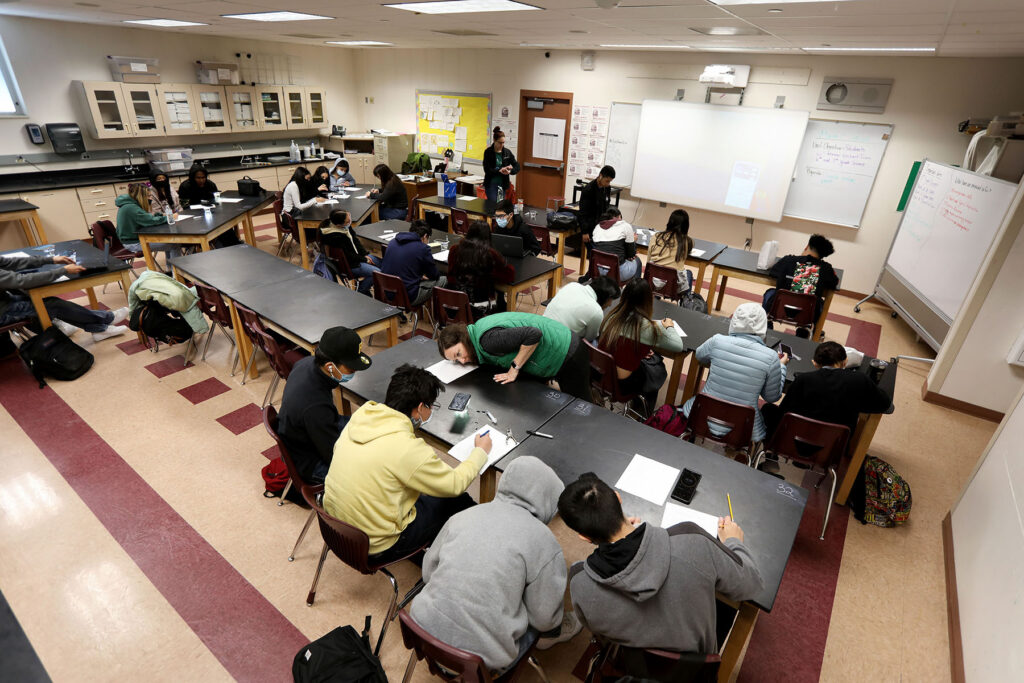
The emphasis on food and agriculture is notable at an urban school named for the late “Daddy Bruce” Randolph Sr., a Denver icon famous for his Five Points barbecue restaurant and for feeding thousands of people in need each Thanksgiving. “A lot of our families are deeply engaged in work around food security. So when we think about the needs of our community, urban agriculture really could be something that is serving needs. It can also bring some really amazing opportunities for kids,” said Melissa Boyd, principal at Bruce Randolph School.
The HORT 100 class piloted at Bruce Randolph, co-taught by Bousselot and science instructor Rhiannon Torino, is the same as beginning horticulture classes for collegians on the CSU campus in Fort Collins. Students learned about soil health, plant nutrients, and chemical reactions; they learned about cultivating fruits, vegetables, and ornamental plants.
Like their college counterparts, Bruce Randolph students earned four hours of science credits for completing HORT 100; they could apply the credits to both high school and college course requirements. These credits – and the immersion in college-level learning – are designed to give students a jump-start on a higher education. “It’s exciting,” said Carrillo, a college-bound student. “It kind of gives you a sense of what college will be like.”
Education in food and agriculture is meaningful for students from a Denver community known as a food desert, where fresh fruits and vegetables are not readily available, Bousselot noted. Moreover, the community struggles with air pollution and soil contamination from its history of heavy industry, making it a fitting place for thinking anew about how and where to grow food – for instance, in urban settings such as hydroponic gardens, greenhouses, and green roofs. “This is giving students the opportunity to learn about farming in the place where they are, which is a challenge in an urban area,” Bousselot said. “It seems counterintuitive, but this is the perfect place for that education.”
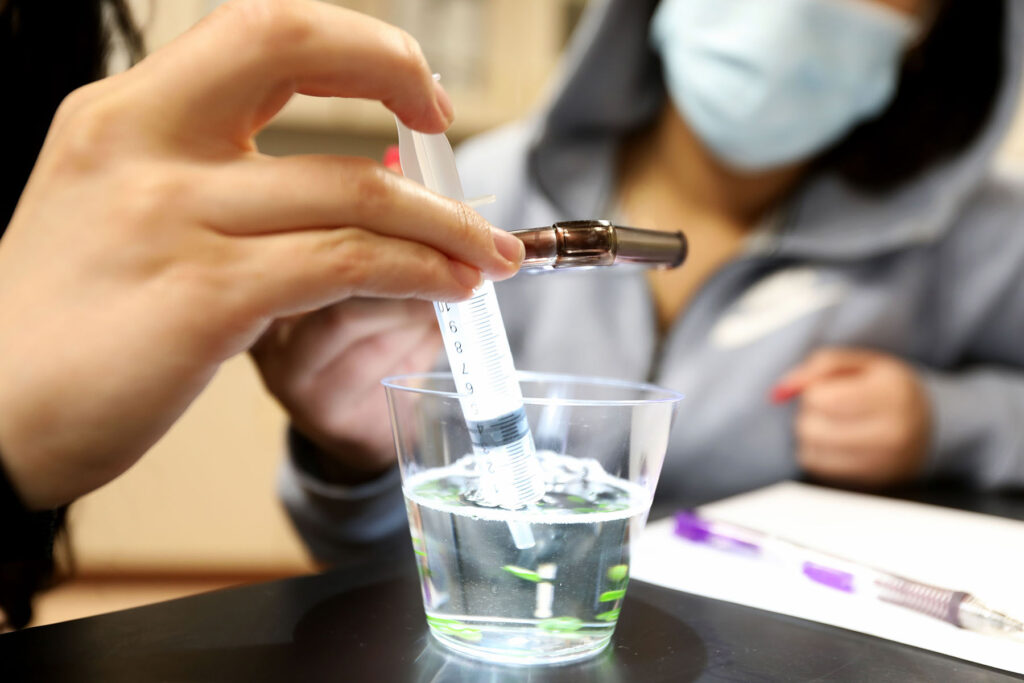
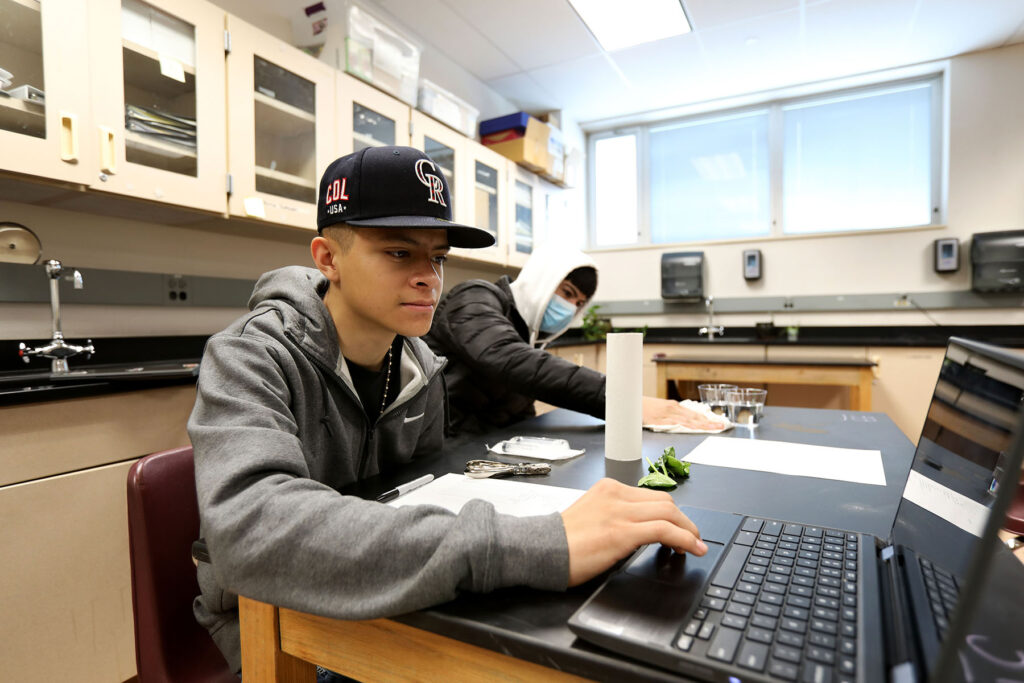
Left: Students use cellphone lights in a photosynthesis experiment. Right: Jonathan Rodriguez-Rodriguez conducts an experiment with guidance from Jennifer Bousselot and is among about two dozen Bruce Randolph students who enrolled in a pilot course called HORT 100 to earn science credits that fulfill requirements in both high school and college.
Top: Students use cellphone lights in a photosynthesis experiment. Bottom: Jonathan Rodriguez-Rodriguez, conducts an experiment with guidance from Jennifer Bousselot and is among about two dozen Bruce Randolph students who enrolled in a pilot course called HORT 100 to earn science credits that fulfill requirements in both high school and college.
Also during the 2021-2022 school year, Bruce Randolph started a hydroponic farm with a $530,000 grant from a city program called Healthy Food for Denver’s Kids. Last spring, the school was turning out 300 to 500 pounds of fresh produce per week at the hydroponic farm – and anticipated growing a total of 10,000 pounds of produce per year – all for the school cafeteria and local families, said Sarah Peterson, a science teacher coordinating agricultural endeavors at Bruce Randolph. The school cafeteria uses the produce for salads, wraps, and even kale chips. The operation is supported by Teens for Food Justice, a nonprofit that promotes school-based hydroponic farms to improve food security.
As students and staff prepared for a grand opening in April, the new hydroponic farm glowed like a green field and already had become a lush magnet for students. Basil, lettuce, bok choy, spinach, Swiss chard, and the creeping tendrils of cucumbers filled tall tiers of lighted growing trays. Students adopted seedlings and dropped by to check on their plants before and between classes. “It’s a really cool experience to see the growing process, and we really enjoyed harvesting and planting and all of that,” Cindy Vasquez-Orozco, a junior, told Denver7 News at the opening. “I feel proud of all of my classmates and how far this farm has come.”
Students in newly established Introduction to Agriculture classes used the hydroponic farm as an everyday classroom, where they learned fundamentals of growing plants in nutrient solutions, without the need for soil. Next door to the hydroponic room, a teaching kitchen served as the place where students learned what to do with some of the green growing things. They discovered how to prepare pizza piled with arugula and how to make bok choy stir fry. A pickle-making class was planned.
“A lot of these students have never heard of these vegetables before,” said Abby Belson, a staff member who oversees the farm. “It was hard to get them to put it in their mouths initially.” Now, students not only eat the veggies but have introduced them to their families.
This is giving students the opportunity to learn about farming in the place where they are, which is a challenge in an urban area. It seems counterintuitive, but this is the perfect place for that education.”
— Jennifer Bousselot, assistant professor of horticulture, Colorado State University
Supplementing the learning and growing in the hydroponic room, raised garden beds stand outside the school entrance near rippling banners that welcome students with the words “brilliance, respect, unity, character, and effort.” The school’s watchwords form the acronym BRUCE, in honor of Daddy Bruce Randolph.
Underlying its focus on agriculture and food, the school is piloting a career and technical education program called AgConnect Pathway for Denver Public Schools. The program establishes an agricultural curriculum and simultaneously encourages students to follow pathways in food and agriculture from high school to college and careers. Such agricultural education, and companion FFA programs, are familiar in many rural and exurban schools, but the field of study would not otherwise have been open to students in this urban slice of Denver, Boyd said. CSU Spur has supported formation of the AgConnect Pathway and, with the opening of the Terra building, offers a plethora of new learning resources for students at Bruce Randolph and elsewhere – from an expansive greenhouse to green roofs, a food innovation laboratory, and cutting-edge agricultural research projects.
Meantime, Bruce Randolph plans to build its own greenhouse with funding help from the Denver Public Schools Foundation. Bousselot already is planning for the next HORT 100 course, which will take advantage of Bruce Randolph’s hydroponic farm in the coming academic year and could lead to similar offerings at other Colorado schools. There are also additional college-level agricultural courses in the works. And Bruce Randolph is launching an FFA chapter focused on urban agriculture.
“With these programs, our kids have a long-term way to contribute to our community,” Boyd said. “This is not just so we can grow greens for fun. These resources are here for a purpose. Big picture, I hope that we end up with a program that allows students to say, ‘I see a career where I can contribute to my community. I want to be a change agent.’”
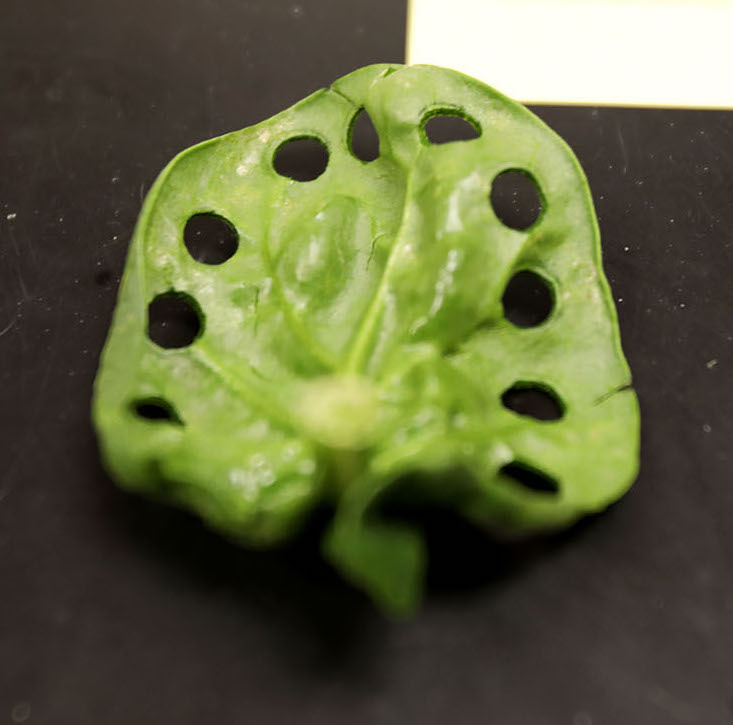

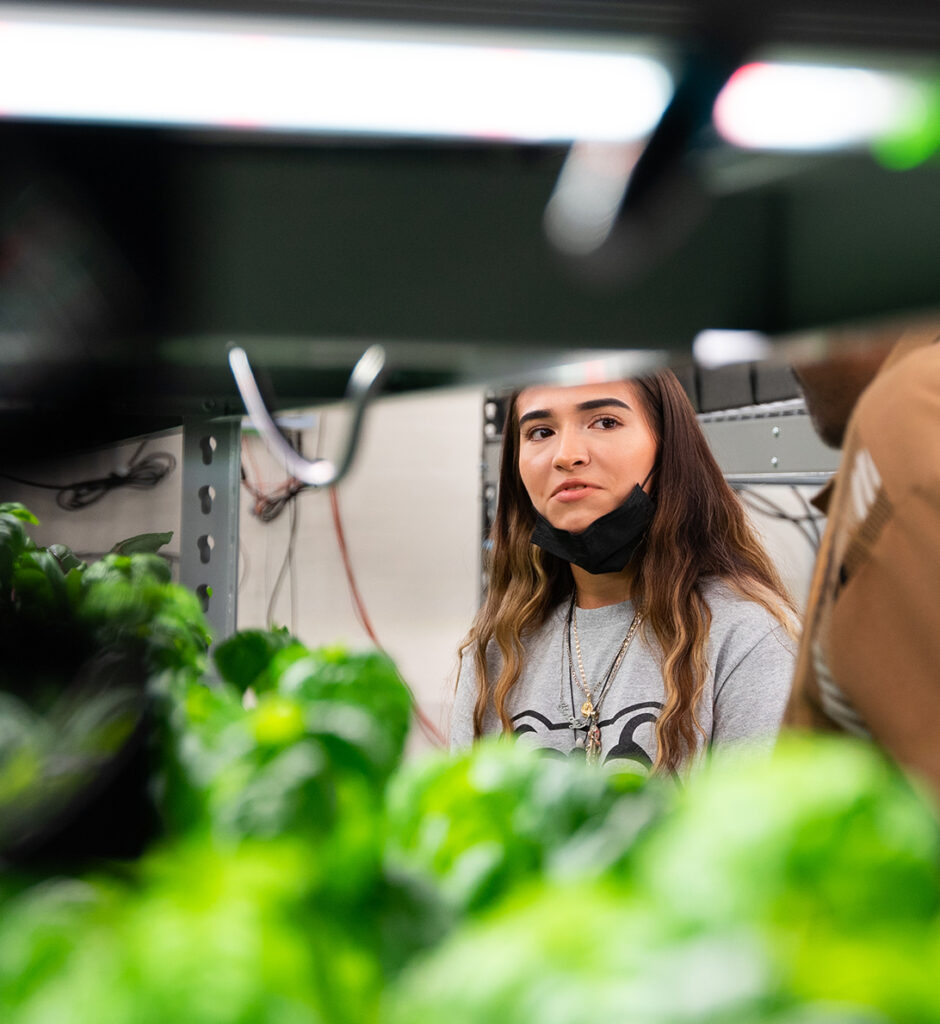
Top left: Students use disks from spinach leaves in a class experiment. Bottom left: Romaine lettuce sprouts in a newly established hydroponic farm at Bruce Randolph School. Right: Cindy Vasquez-Orozco is among the Bruce Randolph students who tend the hydroponic farm, which produces leafy greens and other vegetables for the school cafeteria and for community residents. Photography: Kevin Samuelson / CSU System
Top: Students use disks from spinach leaves in a class experiment. Middle: Romaine lettuce sprouts in a newly established hydroponic farm at Bruce Randolph School. Bottom: Cindy Vasquez-Orozco is among the Bruce Randolph students who tend the hydroponic farm, which produces leafy greens and other vegetables for the school cafeteria and for community residents. Photography: Kevin Samuelson / CSU System
During a class session in April, Bousselot taught students how to write a scientific paper based on an experiment that compared growing bean and spinach plants in the dark and in light. She then gave students the task of replanting pansies to take home. “I have learned how you have to be careful,” said Tanya Valles, as she tucked her plant, with its yellow nodding blossom, into a coconut fiber cup and patted a handful of soil around it. Next, she gave it just enough water to moisten it to the tips of its roots. As Valles worked, she said she hopes to attend college and become a teacher – possibly a science teacher.
As students prepared to leave, Bousselot urged them to make good use of their pansies, which she called “miracles” because they can survive Colorado winters. “Take them home and put them on your windowsills. They will help you study for your finals,” she said.
At the start of class, Quiñonez had given students a pep talk, reminding them that they can overcome hardships to attend college. His own story proves the point: Quiñonez grew up laboring in farm fields alongside his family; when he enrolled in college, he was a nontraditional, married student holding down two jobs. Now, he’s a student adviser pursuing a doctorate in higher education leadership at Colorado State University.
During his talk as a guest in HORT 100, Quiñonez urged students to make use of the four college science credits they earned – good at any university they choose. The important thing is to choose further education, he told the students. He was a perfect role model for the teenagers, who attend a school with 99 percent minority students, most Hispanic; more than 90 percent of the student body is economically disadvantaged, and many could be the first in their families to attend college. Quiñonez felt as sure of these potential first-generation students as he did about a pansy blossoming with the right soil and water.
“I see the gap. I see the need,” he said. “And, here, I am seeing the hope.”
Photo at top: Leafy greens grow in a new hydroponic farm at Bruce Randolph School; the produce harvested is used in the school cafeteria and is distributed to local families. Photo: Kevin Samuelson / CSU System
SHARE
